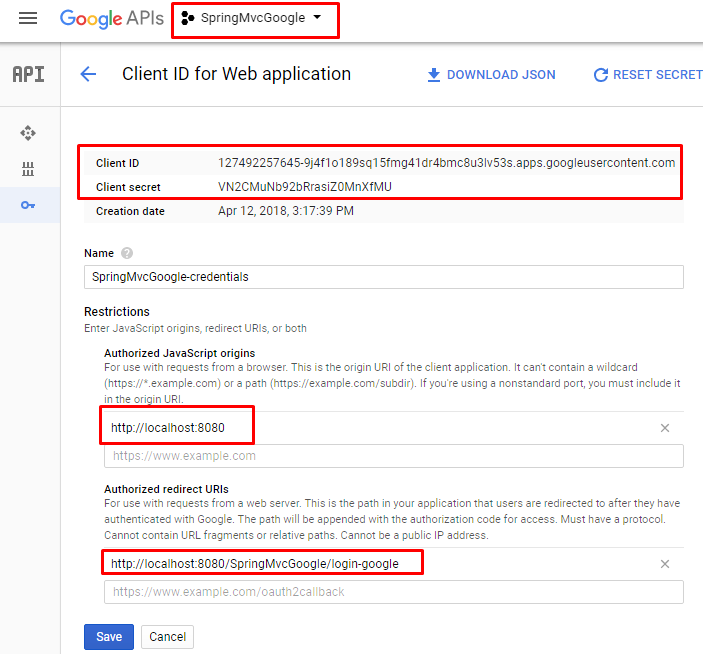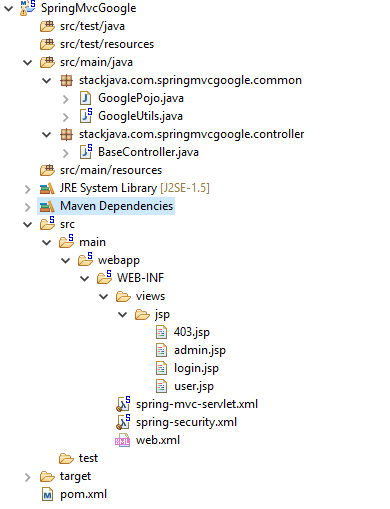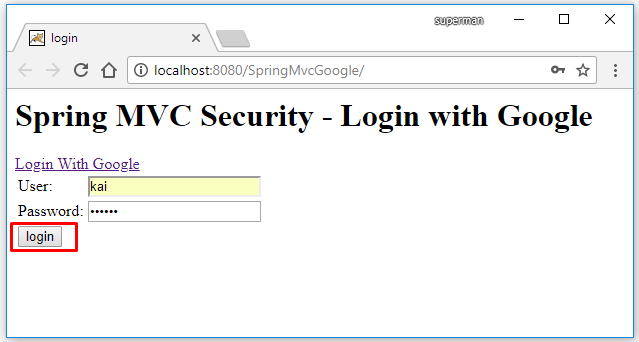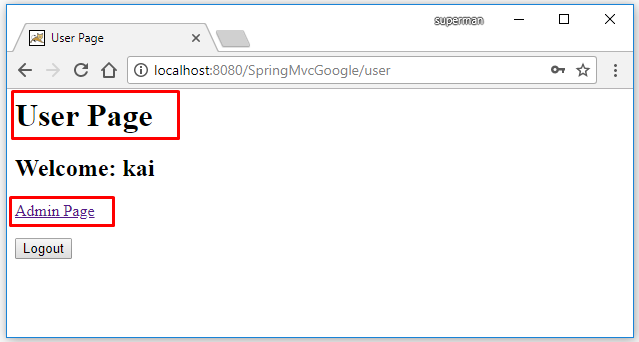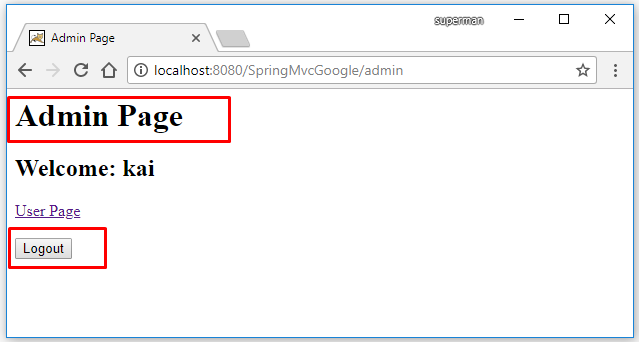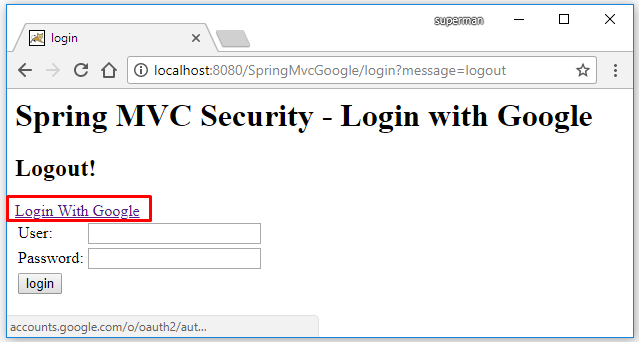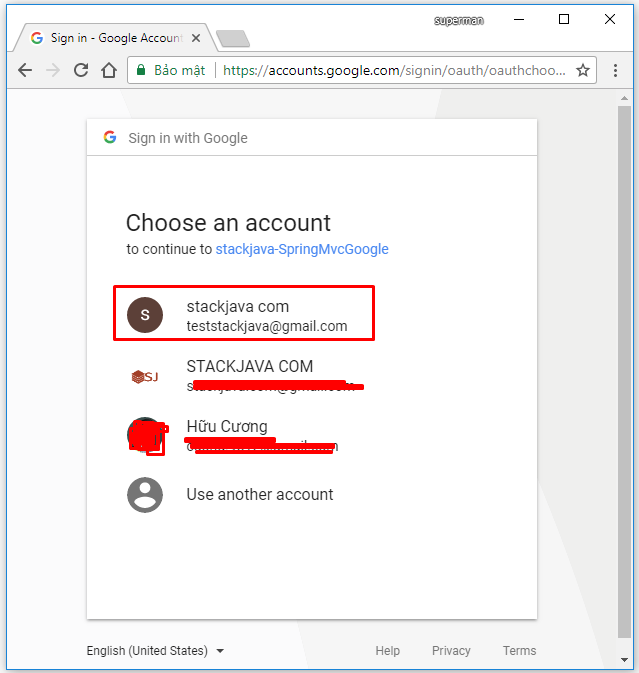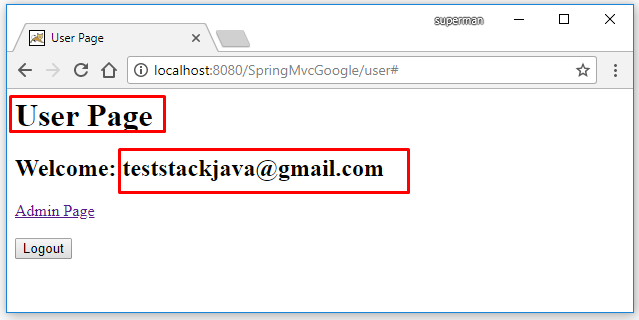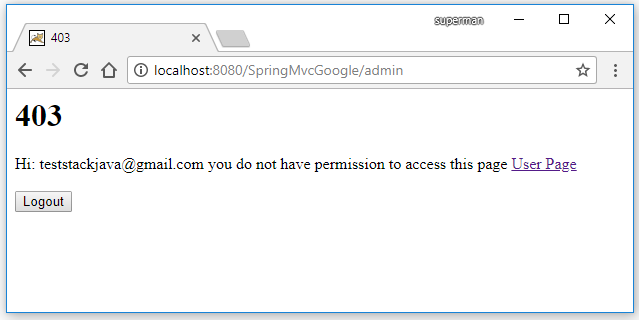Code ví dụ Spring MVC đăng nhập bằng google/gmail.
(Xem lại: Code ví dụ JSP Servlet login bằng Google (Gmail/Google+))
(Xem lại: Code ví dụ Spring Boot Security login bằng Google (Gmail))
Các công nghệ sử dụng:
- Spring 5.0.2.RELEASE
- Spring Security 5.0.2.RELEASE
- Maven
- Tomcat
- JDK 1.8
- Eclipse + Spring Tool Suite
Tạo ứng dung/project trên google API
(Xem lại: Tạo ứng dụng google+ để đăng nhập thay tài khoản)
Ở đây mình tạo ứng dụng “stackajva-demo-login” với:
- Client ID = 127492257645-9j4f1o189sq15fmg41dr4bmc8u3lv53s.apps.googleusercontent.com
- Client Secret = VN2CMuNb92bRrasiZ0MnXfMU
Tạo Maven Project
Thư viện sử dụng:
<project xmlns="http://maven.apache.org/POM/4.0.0" xmlns:xsi="http://www.w3.org/2001/XMLSchema-instance"
xsi:schemaLocation="http://maven.apache.org/POM/4.0.0 http://maven.apache.org/xsd/maven-4.0.0.xsd">
<modelVersion>4.0.0</modelVersion>
<groupId>stackjava.com</groupId>
<artifactId>SpringMvcGoogle</artifactId>
<version>0.0.1-SNAPSHOT</version>
<packaging>war</packaging>
<properties>
<spring.version>5.0.2.RELEASE</spring.version>
<spring.security.version>5.0.2.RELEASE</spring.security.version>
<jstl.version>1.2</jstl.version>
</properties>
<dependencies>
<!-- Spring MVC -->
<dependency>
<groupId>org.springframework</groupId>
<artifactId>spring-webmvc</artifactId>
<version>${spring.version}</version>
</dependency>
<!-- Spring Security -->
<dependency>
<groupId>org.springframework.security</groupId>
<artifactId>spring-security-web</artifactId>
<version>${spring.security.version}</version>
</dependency>
<dependency>
<groupId>org.springframework.security</groupId>
<artifactId>spring-security-config</artifactId>
<version>${spring.security.version}</version>
</dependency>
<!-- JSP/Servlet -->
<dependency>
<groupId>javax.servlet.jsp</groupId>
<artifactId>jsp-api</artifactId>
<version>2.2</version>
<scope>provided</scope>
</dependency>
<dependency>
<groupId>javax.servlet</groupId>
<artifactId>servlet-api</artifactId>
<version>2.5</version>
<scope>provided</scope>
</dependency>
<!-- jstl for jsp page -->
<dependency>
<groupId>jstl</groupId>
<artifactId>jstl</artifactId>
<version>${jstl.version}</version>
</dependency>
<!-- org.apache.httpcomponents -->
<dependency>
<groupId>org.apache.httpcomponents</groupId>
<artifactId>fluent-hc</artifactId>
<version>4.5.5</version>
</dependency>
<!-- Jackson -->
<dependency>
<groupId>com.fasterxml.jackson.core</groupId>
<artifactId>jackson-databind</artifactId>
<version>2.9.3</version>
</dependency>
</dependencies>
</project>
Mình sử dụng thêm thư viện httpcomponents để gửi request bên trong code Java và jackson để xử lý dữ liệu JSON
File cấu hình Spring MVC
<?xml version="1.0" encoding="UTF-8"?>
<beans xmlns="http://www.springframework.org/schema/beans"
xmlns:xsi="http://www.w3.org/2001/XMLSchema-instance" xmlns:context="http://www.springframework.org/schema/context"
xsi:schemaLocation="http://www.springframework.org/schema/beans http://www.springframework.org/schema/beans/spring-beans.xsd
http://www.springframework.org/schema/context http://www.springframework.org/schema/context/spring-context-4.3.xsd">
<context:component-scan base-package="stackjava.com.springmvcgoogle" />
<bean
class="org.springframework.web.servlet.view.InternalResourceViewResolver">
<property name="prefix">
<value>/WEB-INF/views/jsp/</value>
</property>
<property name="suffix">
<value>.jsp</value>
</property>
</bean>
</beans>
File cấu hình Spring Security
<?xml version="1.0" encoding="UTF-8"?>
<beans:beans xmlns="http://www.springframework.org/schema/security"
xmlns:xsi="http://www.w3.org/2001/XMLSchema-instance" xmlns:beans="http://www.springframework.org/schema/beans"
xsi:schemaLocation="http://www.springframework.org/schema/beans http://www.springframework.org/schema/beans/spring-beans.xsd
http://www.springframework.org/schema/security http://www.springframework.org/schema/security/spring-security.xsd">
<http auto-config="true">
<intercept-url pattern="/admin**" access="hasRole('ROLE_ADMIN')" />
<intercept-url pattern="/user**" access="hasRole('ROLE_ADMIN') or hasRole('ROLE_USER')" />
<access-denied-handler error-page="/403"/>
<form-login
login-page="/login"
login-processing-url="/j_spring_security_login"
default-target-url="/user"
authentication-failure-url="/login?message=error"
username-parameter="username"
password-parameter="password" />
<logout logout-url="/j_spring_security_logout"
logout-success-url="/login?message=logout" delete-cookies="JSESSIONID" />
</http>
<authentication-manager>
<authentication-provider>
<user-service>
<user name="kai" password="{noop}123456" authorities="ROLE_ADMIN" />
<user name="sena" password="{noop}123456" authorities="ROLE_USER" />
</user-service>
</authentication-provider>
</authentication-manager>
</beans:beans>
File controller
package stackjava.com.springmvcgoogle.controller;
import java.io.IOException;
import javax.servlet.http.HttpServletRequest;
import org.apache.http.client.ClientProtocolException;
import org.springframework.beans.factory.annotation.Autowired;
import org.springframework.security.authentication.UsernamePasswordAuthenticationToken;
import org.springframework.security.core.context.SecurityContextHolder;
import org.springframework.security.core.userdetails.UserDetails;
import org.springframework.security.web.authentication.WebAuthenticationDetailsSource;
import org.springframework.stereotype.Controller;
import org.springframework.ui.Model;
import org.springframework.web.bind.annotation.RequestMapping;
import org.springframework.web.bind.annotation.RequestParam;
import stackjava.com.springmvcgoogle.common.GooglePojo;
import stackjava.com.springmvcgoogle.common.GoogleUtils;
@Controller
public class BaseController {
@Autowired
private GoogleUtils googleUtils;
@RequestMapping(value = { "/", "/login" })
public String login(@RequestParam(required = false) String message, final Model model) {
if (message != null && !message.isEmpty()) {
if (message.equals("logout")) {
model.addAttribute("message", "Logout!");
}
if (message.equals("error")) {
model.addAttribute("message", "Login Failed!");
}
if (message.equals("google_error")) {
model.addAttribute("message", "Login by Facebook Failed!");
}
}
return "login";
}
@RequestMapping("/login-google")
public String loginGoogle(HttpServletRequest request) throws ClientProtocolException, IOException {
String code = request.getParameter("code");
if (code == null || code.isEmpty()) {
return "redirect:/login?message=google_error";
}
String accessToken = googleUtils.getToken(code);
GooglePojo googlePojo = googleUtils.getUserInfo(accessToken);
UserDetails userDetail = googleUtils.buildUser(googlePojo);
UsernamePasswordAuthenticationToken authentication = new UsernamePasswordAuthenticationToken(userDetail, null,
userDetail.getAuthorities());
authentication.setDetails(new WebAuthenticationDetailsSource().buildDetails(request));
SecurityContextHolder.getContext().setAuthentication(authentication);
return "redirect:/user";
}
@RequestMapping("/user")
public String user() {
return "user";
}
@RequestMapping("/admin")
public String admin() {
return "admin";
}
@RequestMapping("/403")
public String accessDenied() {
return "403";
}
}
Method loginGoogle xử lý kết quả trả về từ google
- Lấy code mà google gửi về sau đó đổi code sang access token
- Sử dụng access token lấy thông tin user (có thể thực hiện lưu lại thông tin vào database để quản lý)
- Chuyển thông tin user sang đối tượng UserDetails để spring security quản lý
- Sử dụng đối tượng UserDetails trên giống như thông tin authentication (tương đương với đăng nhập bằng username/password)
File GoogleUtils.java
Thực hiện gửi request tới google (lấy access_token, lấy thông tin tài khoản)
package stackjava.com.springmvcgoogle.common;
import java.io.IOException;
import java.util.ArrayList;
import java.util.List;
import org.apache.http.client.ClientProtocolException;
import org.apache.http.client.fluent.Form;
import org.apache.http.client.fluent.Request;
import org.springframework.security.core.GrantedAuthority;
import org.springframework.security.core.authority.SimpleGrantedAuthority;
import org.springframework.security.core.userdetails.User;
import org.springframework.security.core.userdetails.UserDetails;
import org.springframework.stereotype.Component;
import com.fasterxml.jackson.databind.JsonNode;
import com.fasterxml.jackson.databind.ObjectMapper;
@Component
public class GoogleUtils {
public static String GOOGLE_CLIENT_ID = "127492257645-9j4f1o189sq15fmg41dr4bmc8u3lv53s.apps.googleusercontent.com";
public static String GOOGLE_CLIENT_SECRET = "VN2CMuNb92bRrasiZ0MnXfMU";
public static String GOOGLE_REDIRECT_URI = "http://localhost:8080/SpringMvcGoogle/login-google";
public static String GOOGLE_LINK_GET_TOKEN = "https://accounts.google.com/o/oauth2/token";
public static String GOOGLE_LINK_GET_USER_INFO = "https://www.googleapis.com/oauth2/v1/userinfo?access_token=";
public static String GOOGLE_GRANT_TYPE = "authorization_code";
public String getToken(final String code) throws ClientProtocolException, IOException {
String response = Request.Post(GOOGLE_LINK_GET_TOKEN)
.bodyForm(Form.form().add("client_id", GOOGLE_CLIENT_ID)
.add("client_secret", GOOGLE_CLIENT_SECRET)
.add("redirect_uri", GOOGLE_REDIRECT_URI).add("code", code)
.add("grant_type", GOOGLE_GRANT_TYPE).build())
.execute().returnContent().asString();
ObjectMapper mapper = new ObjectMapper();
JsonNode node = mapper.readTree(response).get("access_token");
return node.textValue();
}
public GooglePojo getUserInfo(final String accessToken) throws ClientProtocolException, IOException {
String link = GOOGLE_LINK_GET_USER_INFO + accessToken;
String response = Request.Get(link).execute().returnContent().asString();
ObjectMapper mapper = new ObjectMapper();
GooglePojo googlePojo = mapper.readValue(response, GooglePojo.class);
System.out.println(googlePojo);
return googlePojo;
}
public UserDetails buildUser(GooglePojo googlePojo) {
boolean enabled = true;
boolean accountNonExpired = true;
boolean credentialsNonExpired = true;
boolean accountNonLocked = true;
List<GrantedAuthority> authorities = new ArrayList<GrantedAuthority>();
authorities.add(new SimpleGrantedAuthority("ROLE_USER"));
UserDetails userDetail = new User(googlePojo.getEmail(),
"", enabled, accountNonExpired, credentialsNonExpired, accountNonLocked, authorities);
return userDetail;
}
}
File GooglePojo.java
Dùng để chứa các thông tin tài khoản (email, name…) gửi về từ google.
package stackjava.com.sbgoogle.common;
public class GooglePojo {
private String id;
private String email;
private boolean verified_email;
private String name;
private String given_name;
private String family_name;
private String link;
private String picture;
// getter-setter
}
Các file view:
<%@taglib prefix="c" uri="http://java.sun.com/jsp/jstl/core"%>
<html>
<head>
<title>login</title>
</head>
<body>
<h1>Spring MVC Security - Login with Google</h1>
<h2>${message}</h2>
<a href="https://accounts.google.com/o/oauth2/auth?scope=email&redirect_uri=http://localhost:8080/SpringMvcGoogle/login-google&response_type=code
&client_id=127492257645-9j4f1o189sq15fmg41dr4bmc8u3lv53s.apps.googleusercontent.com&approval_prompt=force">Login With Google</a>
<form name='loginForm' action="<c:url value='j_spring_security_login' />" method='POST'>
<table>
<tr>
<td>User:</td>
<td><input type='text' name='username'></td>
</tr>
<tr>
<td>Password:</td>
<td><input type='password' name='password' /></td>
</tr>
<tr>
<td colspan='2'><input name="submit" type="submit" value="login" /></td>
</tr>
</table>
<input type="hidden" name="${_csrf.parameterName}" value="${_csrf.token}" />
</form>
</body>
</html>
<%@taglib prefix="c" uri="http://java.sun.com/jsp/jstl/core"%>
<html>
<head>
<title>Admin Page</title>
</head>
<body>
<h1>Admin Page</h1>
<h2>Welcome: ${pageContext.request.userPrincipal.name}</h2>
<a href="<c:url value="/user" />">User Page</a>
<br/><br/>
<form action="<c:url value="/j_spring_security_logout" />" method="post">
<input type="hidden" name="${_csrf.parameterName}" value="${_csrf.token}" />
<input type="submit" value="Logout" />
</form>
</body>
</html>
<%@taglib prefix="c" uri="http://java.sun.com/jsp/jstl/core"%>
<html>
<head>
<title>User Page</title>
</head>
<body>
<h1>User Page</h1>
<h2>Welcome: ${pageContext.request.userPrincipal.name}</h2>
<a href="<c:url value="/admin" />">Admin Page</a>
<br/><br/>
<form action="<c:url value="/j_spring_security_logout" />" method="post">
<input type="hidden" name="${_csrf.parameterName}" value="${_csrf.token}" />
<input type="submit" value="Logout" />
</form>
</body>
</html>
<%@taglib prefix="c" uri="http://java.sun.com/jsp/jstl/core"%>
<html>
<head>
<title>403</title>
</head>
<body>
<h1>403</h1>
<span>Hi: ${pageContext.request.userPrincipal.name} you do not have permission to access this page</span>
<a href="<c:url value="/user" />">User Page</a>
<br/><br/>
<form action="<c:url value="/j_spring_security_logout" />" method="post">
<input type="hidden" name="${_csrf.parameterName}" value="${_csrf.token}" />
<input type="submit" value="Logout" />
</form>
</body>
</html>
Demo:
Đăng nhập bình thường bằng tài khoản kai/123456
Đăng nhập bằng tài khoản google (gmail)
Chọn tài khoản gmail sẽ dùng để đăng nhập.
Tài khoản đăng nhập qua gmail không có quyền truy cập trang /admin vì chỉ có role user
Code ví dụ Spring MVC đăng nhập bằng google/gmail stackjava.com
Okay, Done!
Download code ví dụ trên tại đây.
(Xem thêm: Code ví dụ Spring MVC Security, login bằng Facebook)
References:
